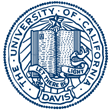
This REU program was funded through NSF PHY-0649297.
Lick Observatory
The first field trip is generally on the first Saturday of the program. This year it was a private tour of Lick Observatory on Mount Hamilton. We arrived early enough for lunch, frisbee, and a short hike in Joseph Grant Park, partway up Mount Hamilton. At Lick we saw several of the telescopes and learned about the research now done with them. Although the Lick telescopes are no longer the largest in the world, and their location on a small mountain near a heavily populated area is less than ideal, they are still respectable instruments that remain useful for certain types of projects. One such category includes projects that require longer viewing times than can be obtained on newer, larger telescopes. Another has projects that rely on specialized state-of-the-art spectrometers that can be fitted to the Lick telescopes. Our tour guide also told the story of Joseph Lick and the founding of the observatory. We finished with a viewing through what was once the largest refracting telescope in the world. A high point was the comparison to the view from a small locator telescope. The contrast with the large refractor gave some sense of why scientists were so excited when they first used that telescope more than 100 years ago.
Lawrence Livermore National Laboratory
On our daytrip to Livermore the group saw the National Ignition Facility for work on fusion, the Center for Accelerator Mass Spectrometry, which supports research in areas from geology to bioscience, and the Axion Dark Matter Experiment.
Lake Tahoe
On Saturday morning we drove from Davis to the Tahoe Environmental Research Center, an award-winning "green" building. We learned about the innovations in the building itself as well as about environmental science at Lake Tahoe, particularly efforts to maintain the lake's clarity despite its heavy use. After lunch at the home of Professor Chiang and her family, who generously hosted the REU group for a fifth summer, most of the group hiked to a nearby group of small lakes. On Sunday various students went rock climbing, bicycling along the shore of Lake Tahoe, or hiking and swimming.
KeckCAVES
KeckCAVES, in the basement of the physics building at UC Davis, is a three-dimensional visualization environment. Projectors along three walls of a cube produce slightly different images for the viewer's right and left eyes. The images alternate rapidly in time and are funneled to the correct eye through special goggles. One of the graduate students in the Computational Complex Systems group demonstrated the "cave" for us. We saw solutions of partial differential equations; a globe with earthquake epicenters marked in three dimensions so a user could view depth dependence along faults; a buckyball that could be compressed, twisted, or even ripped apart atom by atom and reassembled; and the beginnings of a game where the user wanders through the halls of a castle.